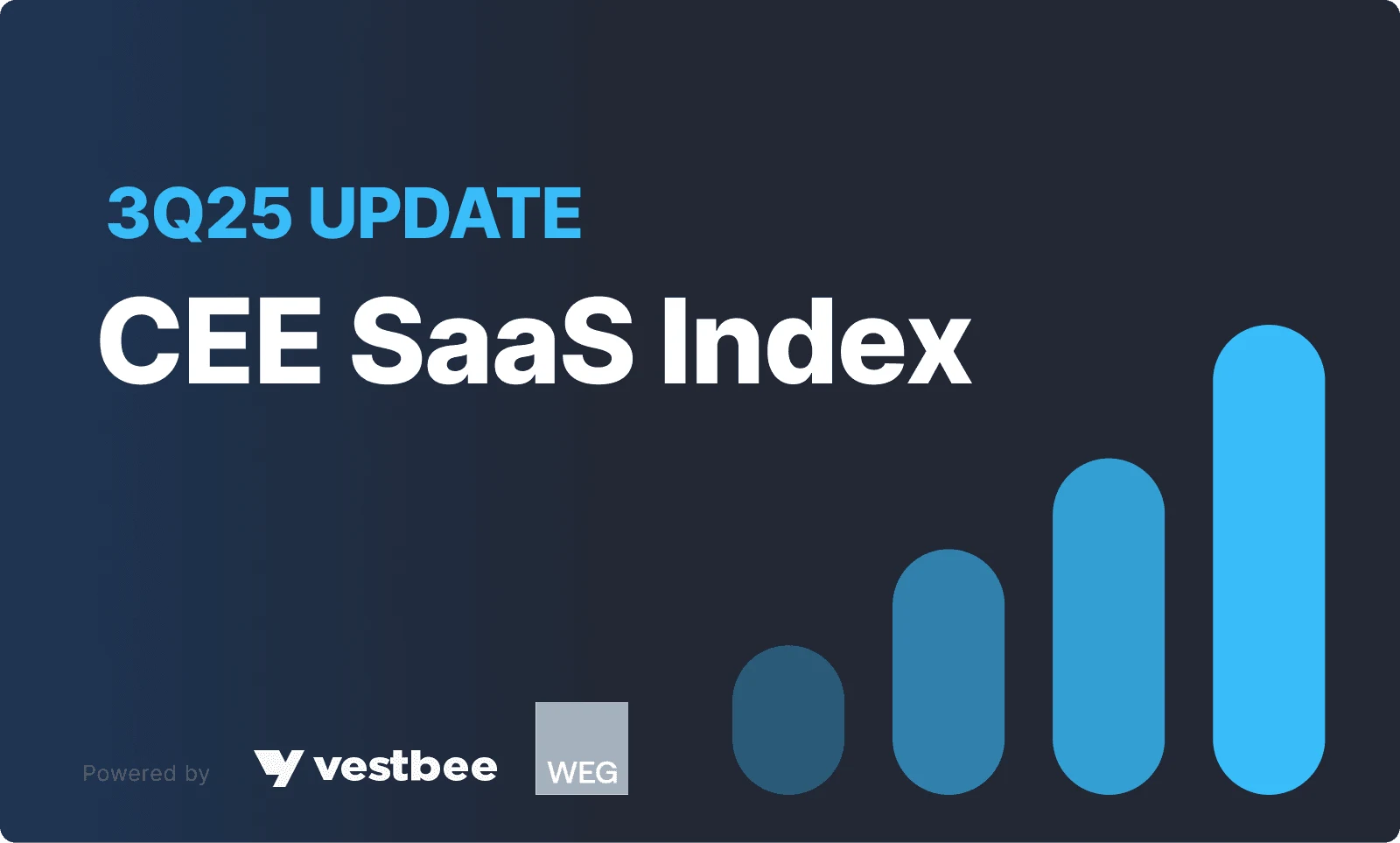It seems like no week in 2025 passed by without some headline-making news about AI. The year was defined by record-scale announcements: SoftBank and Oracle committed $500 billion to build AI supercomputers, while OpenAI and Nvidia launched a $100 billion fund to secure US leadership in advanced chips. On the other side of the world, China has kept pace, and Chinese tech giants Alibaba and Tencent accelerated investments to meet Beijing’s goal of leading the AI by 2030.
This wave of AI commitments triggered a historic response across global financial markets. Since ChatGPT’s release in 2022, AI-linked stocks have added around $17.5 trillion in market value, driving three-quarters of the S&P 500’s gains and pushing already established tech giants like Nvidia and Microsoft to record highs.
With so much happening at once, Vestbee decided to look at the broader picture — from how AI giants are shaping the market, how venture capital is responding, and how culture and consumer behavior are shifting with it. Many compare this moment to the early days of the internet, so we went to the data to examine whether the analogy holds, and whether we’re truly entering a new technological paradigm.
AI dominates global venture capital in Q3 2025
According to KPMG, global venture capital investment rose to $120 billion in Q3 2025, up from $112 billion the previous quarter, with nearly all of the growth driven by AI. Developers of foundational models and AI platforms secured the largest rounds: Anthropic raised $13 billion, Elon Musk’s xAI $10 billion, and Reflection AI $1 billion, as investors were racing to back core AI infrastructure. Beyond the US, Canada’s Cohere raised $600 million and China’s MiniMax AI — $300 million, all part of a broader wave of capital chasing AI-native startups.
GenAI,a category that includes all major AI labs, accounted for 60% of 2025’s total AI capital, with 90% of all that funding going to major mega-rounds of $250 million and more.
In Europe, AI is also the clear standout. Pitchbook reports that €17.1 billion flowed into the sector in Q3 2025, representing 39% of all European venture value, up from 34.5% mid-year. The continent’s largest rounds came from Mistral AI (€1.3 billion) and Nscale (€1.27 billion), both backed by major corporations including ASML, NVIDIA, and Dell.
Deal activity has become increasingly concentrated in late-stage funding, with average round sizes rising. Early-stage AI startups continue to attract first-time capital, but follow-on rounds outside the sector are slowing — fintech and life sciences, once the mainstays of European venture, are both on track for double-digit declines as investors redirect funds toward AI. It seems like for the first time since the early years of the internet boom, venture capital is revolving around a single technology thesis.
Rising valuations
The buzz around AI is reflected in concrete numbers, and the scale is huge. 41% of the world’s Top 100 most valuable private tech firms are now AI companies, up from 16% in 2022. Investor-founder engagement around AI has also surged 40x higher since 2020, reflecting a shift from curiosity to full-scale competition.
The sharpest acceleration is visible among model developers and AI infrastructure players. OpenAI’s valuation surged from $29 billion in 2023 to more than $150 billion in 2025, while Anthropic jumped from $4 billion to over $50 billion during the same period. xAI’s value climbed past $60 billion less than a year after launch, and CoreWeave crossed $20 billion on the strength of AI-compute demand. At this pace, valuations for leading AI labs have effectively doubled every six to nine months, marking one of the fastest growth curves in modern US private-market history.
In Europe, the trend is similar, though on a smaller scale. Like the US, capital is concentrating at the top: a handful of European model developers now capture the majority of funding, while smaller applied-AI startups compete for smaller rounds. Some of the biggest AI-first companies on the continent include Helsing, which achieved a $13.2 billion valuation following its most recent €600 million Series D; Mistral AI — $13 billion valuation with a total of $2.9 billion in funding, and Grammarly, now Superhuman, — $13 billion valuation, with a recent debt round of $1 billion. Below the $10 billion valuation mark, there are well-fairing European companies such as Snyk, ElevenLabs, Darktrace, Hugging Face, and Synthesia.
These record valuations raise an obvious question: are business fundamentals keeping pace with investor expectations?
AI valuations VS market performance
For AI companies, everything seems inflated: they register record-high valuations, some achieve very fast revenue growth, and most burn cash at an alarmingly high rate. Still, a leading group of 18 AI-first firms — AI-native apps with more than $50 million in annualized revenue, including OpenAI, Anthropic, Midjourney, Perplexity, Abridge, Synthesia, Replit, EliseAI, Lovable, Glean, ElevenLabs, Cognition — collectively generated $18.5 billion in annualized revenue as of August 2025. In the most recent quarter, smaller AI firms grew 60%, and larger ones 30%, both 1.5x faster than non-AI companies.
Early-stage traction is also strong. Andreessen Horowitz reports that median enterprise AI apps achieve $2 million ARR in their first year, and consumer AI apps reach $4 million ARR. Analysis of the 100 fastest-growing AI companies on Stripe shows that the fastest-growing AI startups hit $5 million in ARR roughly 1.5× faster than the top SaaS firms in 2018. So while valuations look extreme, revenue performance shows that many AI companies are scaling far faster than previous generations of software.
AI revenue and real-world adoption
The rise of generative media companies like ElevenLabs, Synthesia, and Black Forest Labs marks the industry’s transition from early hype to real enterprise adoption. They earn hundreds of millions in annual revenue and are no longer novelty tools; they now provide infrastructure for global brands.
- ElevenLabs doubled its revenue in nine months to $200 million and reached a $6.6 billion valuation. Its customers have created over two million AI voice agents that have managed 33 million conversations in 2026.
- Synthesia surpassed $100 million ARR in April 2025, with 70% of the Fortune 100 as clients. Since its 2021 launch, users have generated over 30 million minutes of avatar-based video.
- Black Forest Labs reportedly reached ~$100 million ARR, growing up 3.5× YoY, with 78% gross margins, including a $140 million two-year deal with Meta.
A similar pattern is emerging in software development. In 2025, the term 'vibe coding' — using natural-language prompts to create code — was named Collins Dictionary’s Word of the Year. Stockholm-based Lovable became a unicorn just eight months after launch, raising a $200 million Series A at a $1.8 billion valuation. San Francisco-based Anysphere, a developer behind the tool Cursor, reached roughly $500 million ARR and a near-$10 billion valuation in mid-2025.
Yet the rewards come with structural risks. Vibe-coding platforms rely heavily on upstream LLM providers and pay steep compute and inference costs, raising questions about the long-term profitability of these business models. Security is also an important issue: in July, attackers exploited an open-source Cursor IDE extension to steal developer credentials and mine $50,000 in cryptocurrency.
For a closer look at the leading tools, business models, and challenges in vibe coding, see our full analysis here.
Liquidity and exit paths for AI companies
After several years of weak exits due to regulatory pressure and economic uncertainty, 2025 has marked a clear rebound in IPOs and M&A. The main driver is the commercialization of AI, which has restored confidence in public markets and intensified competition for top talent.
The standout moment was CoreWeave’s $23 billion IPO — the biggest tech listing of the year. Its success showed that investors are ready to back large-scale AI infrastructure.
M&A activity in the US has also accelerated as major corporations rush to build full AI ecosystems. AMD acquired Silo AI, Brium, and Untether AI to strengthen its data-center and inference capabilities, while OpenAI moved into AI hardware with a $6.5 billion purchase of io Products. "Acquihires" have also increased, with big tech companies buying smaller AI teams mainly for engineering talent.
In Europe, M&A activity has reached record levels: over 100 AI-native startups have been acquired so far in 2025, surpassing last year’s 85. Notable transactions include Workday’s $1.1 billion acquisition of Sweden’s Sana and NiCE’s near-$1 billion purchase of Germany’s Cognigy. Even European AI champions like Mistral are turning into acquirers, integrating smaller players such as Mithril Security.
Together, these moves illustrate how AI’s surge has reopened liquidity channels and repositioned both IPO and M&A markets as central engines of the sector’s next growth phase.
Big tech is spending big time
The biggest tech companies are no longer just building AI infrastructure — they’re also funding the startups that rely on it. Microsoft, Google, Amazon, and NVIDIA now account for more than half of all global AI-related venture investment, a level of concentration not seen since the dot-com or mobile booms. And their spending keeps rising: Microsoft plans even larger data-center investments through 2026, Meta increased its 2025 budget to $116–118 billion (driven partly by a tenfold surge in AI-generated media on its Vibes app), and Alphabet raised capital spending to $91–93 billion, with Google Cloud revenue up 34% YoY to $15 billion thanks to strong AI demand.
But this constant investment highlights a core tension: money is flowing into AI much faster than profits are emerging. As valuations climb and monetization lags, public investors are starting to reassess risk. The Nasdaq Composite dropped 3% in a single week — its sharpest fall since the 2018 tariff shock — with Palantir (-11%), Oracle (-9%), and Nvidia (-7%) leading the declines, and even Meta and Microsoft pulling back by around 4%. Analysts say the correction reflects overstated valuations and a widening gap between AI expectations and short-term financial results.
AI is transforming technology, venture capital, and user behavior at record speed. In our next AI article, we’ll take a closer look at whether the current surge represents a genuine long-term shift or the early stages of an AI bubble.







